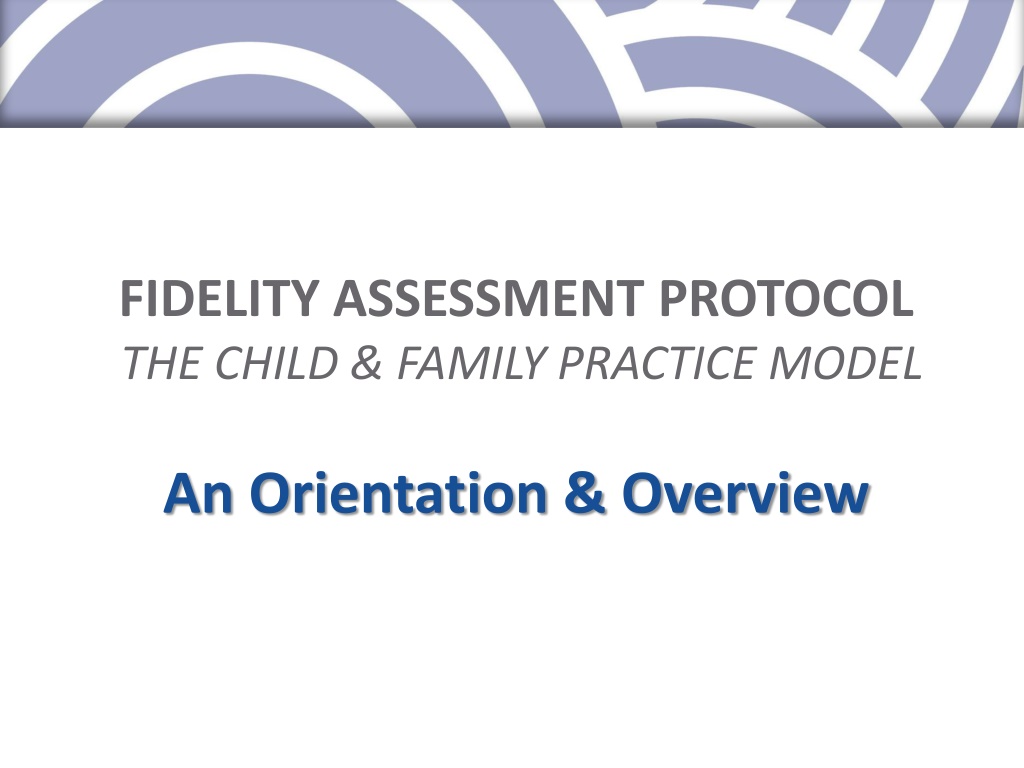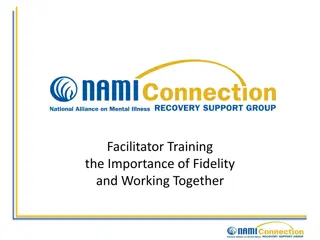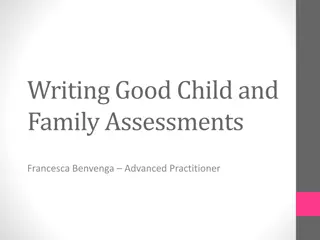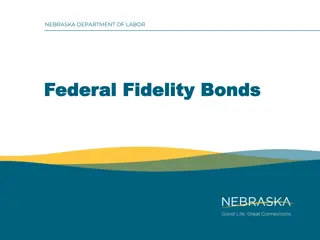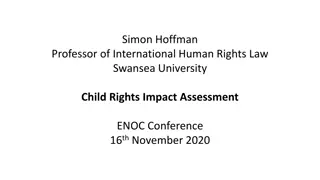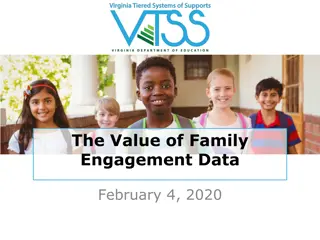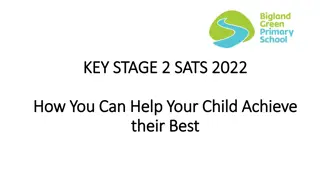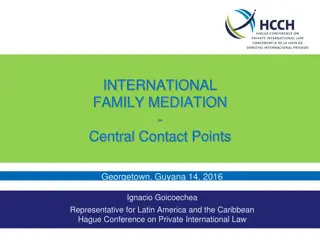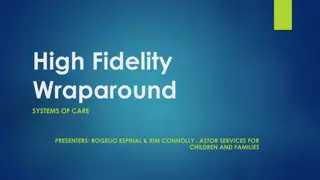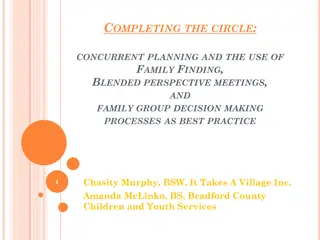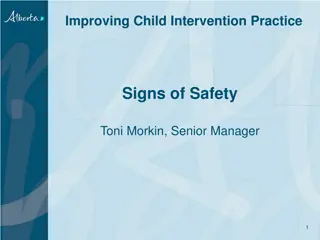Understanding Fidelity Assessment in Child and Family Practice Model
Fidelity assessment (FA) in the Child and Family Practice Model (CFPM) ensures consistent implementation by evaluating how well the model is applied. It is not a performance evaluation but a tool to strengthen support and accountability in working with children and families, aiming to improve outcomes over time. The assessment helps identify effective components and practices to enhance implementation. Shift in accountability emphasizes the role of data in informing agency support and addressing implementation barriers.
- Fidelity assessment
- Child and Family Practice Model
- Accountability shift
- Implementation support
- Outcome improvement
Download Presentation

Please find below an Image/Link to download the presentation.
The content on the website is provided AS IS for your information and personal use only. It may not be sold, licensed, or shared on other websites without obtaining consent from the author. Download presentation by click this link. If you encounter any issues during the download, it is possible that the publisher has removed the file from their server.
E N D
Presentation Transcript
FIDELITY ASSESSMENT PROTOCOL THE CHILD & FAMILY PRACTICE MODEL An Orientation & Overview
Goals for FA Orientation Community Partner and Staff FA Observers Social Workers/Supervisors Define Fidelity Assessment Process Define Fidelity Assessment Process Familiarize with the Process Familiarize with the Process Roles & Expectations Roles & Expectations Feel Comfortable being Observed Familiarize with the Tools Feel Comfortable as Assessors
What Is Fidelity Assessment? Fidelity assessment (FA) is a process designed to determine if we are effectively and consistently implementing the Child and Family Practice Model (CFPM)
Why Its NOT like a Performance Evaluation Employee Performance Evaluation - assesses an individual employee s job performance and productivity. CFPM Fidelity Assessment - helps us understand how the Practice Model is working and where we can strengthen implementation supports to ensure it is being used consistently with each family, one case to the next, one year to the next.
Shift in Accountability The CFPM Fidelity Assessment represents a SHIFT IN ACCOUNTABILITY. The data is used to determine if the child welfare agency and system are adequately supporting implementation of the Practice Model and addressing barriers encountered in working with children and families.
Why is Fidelity Assessment Important? Over time, the Fidelity Assessment will allow us to: o Build skills to use the model effectively. o Strengthen and align the resources within our organization and system to support use of the Practice Model. o Ensure consistent use of the core elements and practice behaviors in interactions with children and families. o Explore the impact of implementation of the model on child and family outcomes.
Why is Fidelity Assessment Important? Over time, the Fidelity Assessment will allow us to: o Identify active ingredients of the Practice Model those various components and practices in the model that are most closely associated with improved outcomes for children and families. o Better interpret outcomes by considering the effectiveness of the implementation when evaluating the Practice Model.
What Will We Do With the FA Data? The information from the Fidelity Assessments will be considered in conjunction with other implementation data sources such as: o System Support Surveys o Coaching Feedback Surveys o Implementation Driver Assessments
What Will We Do With the FA Data? The combined implementation data sources will be used to: o Make improvements to coaching, training and other organizational supports for the Practice Model. o Improve the consistency of our interactions with families. o Assure the Practice Model remains consistent and effective over time.
What Will We Do With the FA Data? The data will also help us facilitate changes at all levels of our organization to support the Practice Model and ensure we have: o Feedback loops between practitioners and local leadership to assist in the identification of barriers and to communicate updates on the status of resolutions. o Business practices that facilitate access to resources, supports and services to address each family s underlying needs.
Case Selection A case is selected at the following intervals: 1 year after completion of CFPM training Annually on an ongoing basis Using these time periods, the cases on a CFPM- trained caseworker s caseload that meet the following criteria are identified:
Case Selection Part A A 1. The child/family is assigned to a continuing worker that has been trained in and is receiving coaching in implementing the Child and Family Practice Model. A 2. The child/family has been with that worker at least 45 days. (Note: If the worker does not have any cases for at least 45 days, then all cases are included). A 3. The child/family s case has not previously been part of CFPM Fidelity Assessment for this worker.
Case Selection Part B B 1. Of those cases that meet the criteria in Part A, identify all cases on the worker s caseload that are part of the agency s target population. B 2. If there are no target population cases on the caseload, then all cases that meet the criteria in Part A will be considered. A case is then randomly selected from all cases that meet the criteria in Parts A and B above.
FA Team Identification Fidelity Assessment Team will be identified and composed of: o One Implementation Team Member, Coach, Manager or Supervisor (Note: This team member will not be a direct supervisor or ongoing coach for the Social Worker) o One Parent or Community Partner (Note: Parent or Community Partner will recuse themselves if they have prior history with the family or involvement in the case situation that would prevent them from being objective in conducting the Fidelity Assessment)
Team Meeting Prep & Observation Once a case is selected: o The Social Worker is advised of the case selection. o The Social Worker identifies an upcoming meeting between with the family and their natural supports that can be observed. o There is ongoing coordination between the agency representative or team responsible for Fidelity Assessment and the Social Worker so all planning and logistics are coordinated.
Team Meeting Prep & Observation o Priority is given to observation of a teaming meeting process that involves the family and circle of support. o If a teaming meeting (formal or informal) is not available, a home visit is given second priority for the observation. o Observation of a meeting generally occurs within 30 to 45 days of case selection, though this may be extended an additional 15-30 days to accommodate team scheduling and needs.
Team Meeting Prep & Observation PLEASE DO NOT create an additional meeting/visit for the purposes of a Fidelity Assessment. _________________ This is meant to be an observation of ongoing interactions and case management with the family. We also want to do it in the way that is least impactful on your already busy schedules.
Social Workers: What to Do Obtaining Permission: o When scheduling the meeting with the family, explain the purpose of the observation (Fidelity Assessment Introduction (FA-1)) and obtain the parent s permission for the observation to occur. o If at anytime, before or during the observation, a parent will not agree to an observation, their decision for privacy will be respected and will be communicated to the Fidelity Assessment Team. o If this occurs, another case will be randomly selected for the Fidelity Assessment.
Social Workers: What to Do Please schedule your Meeting/Visit ASAP o Obtain parental permission o Schedule meeting with family o E-mail agency Fidelity Assessment Liaison with the following details (cc your Sup/Mgr): Date, Time and Location of Meeting/Visit Names of all individuals and their relationships to child who will be in attendance (including parents, relatives, professionals) Anything else that is important (Safety, parking)
Social Workers: What to Do Meet with the Fidelity Assessment Team 20-30 minutes before the scheduled meeting to review: o Background Information about the meeting o The Recommended Social Worker Script to ask the family s permission for the meeting to be observed o How the Fidelity Assessment Team will interact with the family during the meeting o How the Social Worker will open the meeting in order to set the context for the observers
Team Meeting Observation At the beginning of the meeting the FA Team members: o Introduce themselves and explain that they are attending the meeting to observe the process o Indicate that they will not participate in the discussion The Social Worker re-obtains permission from the family for the observers to be present
Team Meeting Observation When a parent will not agree to an observation, their decision for privacy is respected and the FA Team leaves the meeting without argument. If this occurs, another case will be randomly selected for the Fidelity Assessment.
Team Meeting Observation Each Fidelity Assessment Team member: o Observes the meeting independently while taking notes o Looks at interactions by agency staff with the family team (not meeting facilitation) o Considers how well the family s voice, culture and needs are being lifted up, responded to and incorporated in case planning/decision-making o Focuses on how effectively the family and their team are being supported given their unique culture, context, development and needs
Team Meeting Observation After the team has finished the meeting/planning (case plan/safety plan/visitation plan, etc.) and before the family and their team leave, one FA Team member asks the three End of Meeting Tool questions (OB-2) to all who are present: Qn #1: Provides information and context for the team in moving forward Qn #2 & 3: Provide ratings that integrate important perspectives from the family and their circle of support into the assessment process
Team Meeting Observation Following the family team meeting, the FA Team meets to: o Share perspectives on the meeting interactions and their findings for each item on the Observation Tool o Determine if additional context from the Social Worker is needed to complete their ratings Note: Each observer completes the Observation Tool and makes their own decision about scoring each item. Sharing their findings and perspectives may inform observer ratings, however there is no pressure to do so. Ratings do not need to be the same.
Team Meeting Observation The Impl Team Member, Coach, Supervisor or Manager on the FA Team will participate in a follow-up meeting with the SW and Supervisor to: o Debrief the team meeting o Provide validation and support for participating in the fidelity assessment process o Assist in identifying next steps and support that the Supervisor will provide to the SW based on the observation
FA Team: Things to Keep in Mind Roles & Responsibilities Position of the FA Team in the Observation of the Meeting/Visit Observation Etiquette
Rehearsal Video Team Mtg Family Support Team (http://youtu.be/m0i4nYRUBVw?t=16m36s) o Chris Youth (AA Female Yellow Shirt) o Bobby Chris Father (AA Male Blue Shirt and Vest) o Ms. Sigmund Chris Art Teacher (White Female Red Hair) o Bobby Joe Social Worker (Facilitator) o Felicia Chris Cousin (Young AA Female) o Nancy Chris Legal Guardian (White Female Black Sweater) o April Unit Manager (AA Female w/ Short Hair) o Ms. Moore Family Partner (AA Female in Blue Flower Blouse) o Mrs. Blackwell Chris Grandmother (AA Female Black Green Blouse) o Mr. Blackwell Chris Grandfather (AA Male Red Shirt) o Ms. Walker Juvenile Court Counselor (White Female Short Blonde Hair)
Rehearsal Video Team Mtg After watching the video: 1. Independently complete Observation Tool 2. In affinity groups, discuss ratings and why you rated each question the way you did o Implementation Team Members, Coaches, and Supervisors o Parents and Community Members o Social Workers 3. Large group discussion about the experience
Group Discussion What was this experience like for you? Were there areas that people had different scores? What did you see that may be valuable perspective for other assessors? Overall thoughts or questions?
The Child and Family Practice Model was developed as part of a 5-year federally funded project to reduce long-term foster care. To learn more, visit www.reducefostercarenow.org or contact CFPMinfo@cfpic.org. The contents of this document are solely the responsibility of the authors and do not necessarily represent the official views of the Children's Bureau, which funded the CAPP/CFPM Project under Cooperative Agreement 90CT0153.
